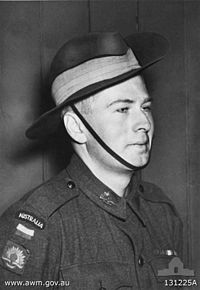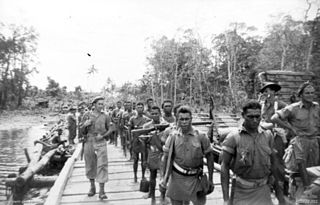
Edward "Ted" Kenna, VC was the last living Australian Second World War recipient of the Victoria Cross, the highest decoration for gallantry "in the face of the enemy" that can be awarded to members of the British and Commonwealth armed forces.

Peter John Badcoe, VC was an Australian recipient of the Victoria Cross, the highest award for gallantry "in the face of the enemy" that can be awarded to British and Commonwealth forces.
Keith Payne, is an Australian recipient of the Victoria Cross, the highest decoration for gallantry "in the presence of the enemy" awarded to members of the British and Commonwealth armed forces. Payne's VC was awarded for his actions during the Vietnam War. Aged 85, he is the last living Australian recipient of the original "Imperial" Victoria Cross.
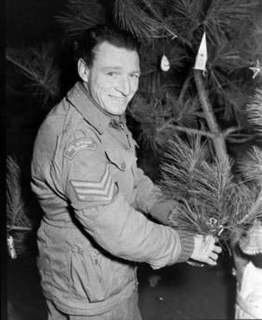
Rayene Stewart "Ray" Simpson, was an Australian recipient of the Victoria Cross, the highest award for gallantry "in the face of the enemy" that can be awarded to members of the British and Commonwealth armed forces. Simpson received his award for actions in Kon Tum Province, South Vietnam on 6 May 1969.

James Rogers, VC was an Australian recipient of the Victoria Cross, the highest award for gallantry in the face of the enemy that can be awarded to British and Commonwealth forces. Rogers received his award for his actions at Thaba 'Nchu in Orange Free State on 15 June 1901 while serving in the South African Constabulary during the Second Boer War.

Samuel George Pearse, VC, MM was an Australian recipient of the Victoria Cross, the highest award for gallantry in the face of the enemy that can be awarded to British and Commonwealth forces. Serving in the Australian Imperial Force during the First World War, he saw action during the final weeks of the Gallipoli Campaign in 1915 and later on the Western Front from 1916 to 1918. Following the Armistice he fought as part of the North Russia Relief Force with the British Army during the North Russia Campaign in 1919. He was killed after charging a machine gun post during an action at Emtsa, in North Russia, for which he was posthumously awarded the Victoria Cross.

Lawrence Carthage Weathers, was a New Zealand-born Australian recipient of the Victoria Cross, the highest award for gallantry in battle that can be awarded to a member of the Australian armed forces. His parents returned to their native South Australia when Weathers was seven, and he completed his schooling before obtaining work as an undertaker in Adelaide. He enlisted as a private in the Australian Imperial Force (AIF) in early 1916, and joined the 43rd Battalion. His unit deployed to the Western Front in France and Belgium in late December. After a bout of illness, Weathers returned to his battalion in time to take part in the Battle of Messines in June 1917, during which he was wounded. Evacuated to the United Kingdom, he rejoined his unit in early December.

Fazal Din VC was an Indian recipient of the Victoria Cross, the highest award for gallantry in the face of the enemy that can be awarded to British and Commonwealth forces.
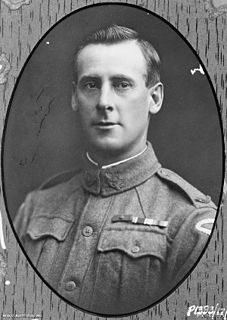
Walter "Wally" Peeler, VC, BEM was an Australian recipient of the Victoria Cross, the highest award for gallantry "in the face of the enemy" that can be awarded to members of the British and Commonwealth armed forces. He was decorated following his actions during the Battle of Broodseinde in October 1917. Then a lance corporal in the Australian Imperial Force, he repeatedly took the lead in the 37th Battalion's advance on well-defended German positions, destroying four machine gun posts and killing more than 30 German soldiers during the battle.

Leslie Thomas "Tom" Starcevich, VC was an Australian recipient of the Victoria Cross, the highest decoration for gallantry "in the face of the enemy" that can be awarded to members of British and Commonwealth armed forces. He received the award as member of the 2/43rd Battalion, during the Borneo campaign of the Second World War.

John Bernard "Jack" Mackey, VC was an Australian recipient of the Victoria Cross, the highest award for gallantry in the face of the enemy that can be awarded to British Commonwealth forces. Mackey was one of twenty Australians to receive the award for actions during the Second World War, receiving his award posthumously for leading an attack on against a strongly defended Japanese position during the Battle of Tarakan in May 1945. He was 22 and serving as a corporal in the 2/3rd Pioneer Battalion at the time of his death.
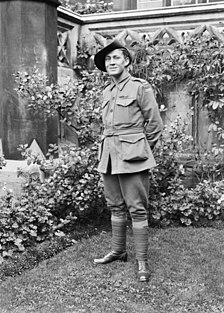
Phillip Davey, was an Australian recipient of the Victoria Cross, the highest award for gallantry in battle that can be awarded to a member of the Australian armed forces. Davey enlisted in the Australian Imperial Force in December 1914, and joined his unit, the 10th Battalion, on the island of Lemnos on 10 April 1915. Along with his battalion, he landed at Anzac Cove, Gallipoli, on 25 April. He fought at Anzac until he was evacuated sick in early November, returning to Australia the following January.
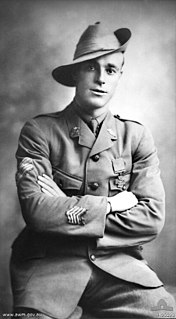
Reginald Roy Inwood, VC was an Australian recipient of the Victoria Cross, the highest award for gallantry in battle that can be awarded to a member of the Australian armed forces. Inwood enlisted in the Australian Imperial Force in August 1914, and along with the rest of the 10th Battalion, he landed at Anzac Cove, Gallipoli on 25 April 1915. He fought at Anzac until being evacuated sick to Egypt in September. He remained there until he rejoined his unit on the Western Front in June 1916. In August, he fought in the Battle of Mouquet Farm.

Albert David "Alby" Lowerson, VC was an Australian recipient of the Victoria Cross, the highest award for gallantry in the face of the enemy that can be awarded to British and Commonwealth forces.
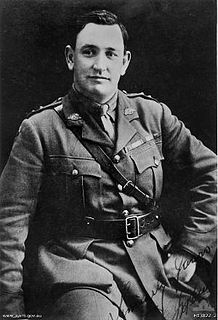
Lawrence Dominic McCarthy, VC was an Australian recipient of the Victoria Cross, the highest award for gallantry in the face of the enemy that can be awarded to British and Commonwealth forces.

Claud Charles Castleton, VC was an Australian recipient of the Victoria Cross, the highest award for gallantry in the face of the enemy that can be awarded to British and Commonwealth forces.

Robert "Bob" Mactier, VC was an Australian recipient of the Victoria Cross, the highest award for gallantry in the face of the enemy that can be awarded to British and Commonwealth forces. He was one of 64 Australians to receive the award for their actions during the First World War, receiving it as a result of deeds performed during the Battle of Mont St Quentin on 1 September 1918. That day, Mactier was a battalion runner serving with the 23rd Battalion, Australian Imperial Force. He was sent forward by an officer to determine the cause of a delay in the battalion moving into its jumping off position. The cause was a well placed enemy machine gun. On his own initiative, Mactier jumped out of the trench and charged the gun, killing its crew of six. He then charged two other machine guns, killing more crews and causing at least 40 enemy to surrender. He was killed by fire from a fourth machine gun, but not before enabling his battalion to form up on time.
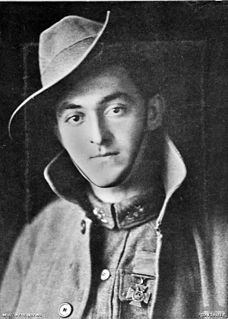
Thomas James Bede Kenny, VC was an Australian recipient of the Victoria Cross, the highest award for gallantry in the face of the enemy that can be awarded to British and Commonwealth forces.

Henry Dalziel, VC was an Australian recipient of the Victoria Cross (VC), the highest award for gallantry in the face of the enemy that can be awarded to British and Commonwealth forces. He was awarded the VC while serving with the Australian Imperial Force during the First World War. Dalziel's VC was the 1,000th awarded. After the war, Dalziel returned to Australia and tried to make a living by farming. Troubled by the injuries he sustained during the war, he left the land and took up factory work. He moved between jobs several times during the 1930s, and led something of a transient lifestyle, even at one stage turning to gold prospecting. In the mid-1930s he rejoined the army in a part-time capacity and during the Second World War served in a training role in Australia. He died in 1965 at the age of 72.
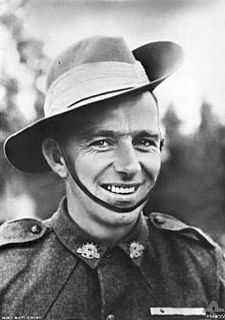
Reginald Roy Rattey, VC was an Australian recipient of the Victoria Cross, the highest award for gallantry "in the face of the enemy" that can be awarded to members of the British or Commonwealth armed forces. He was one of 20 Australians to receive the award for their actions during the Second World War, doing so while serving with the 25th Battalion during the Bougainville Campaign in 1945. After the war, Rattey ran a farm near West Wyalong, New South Wales. He died in 1986 at the age of 67.



